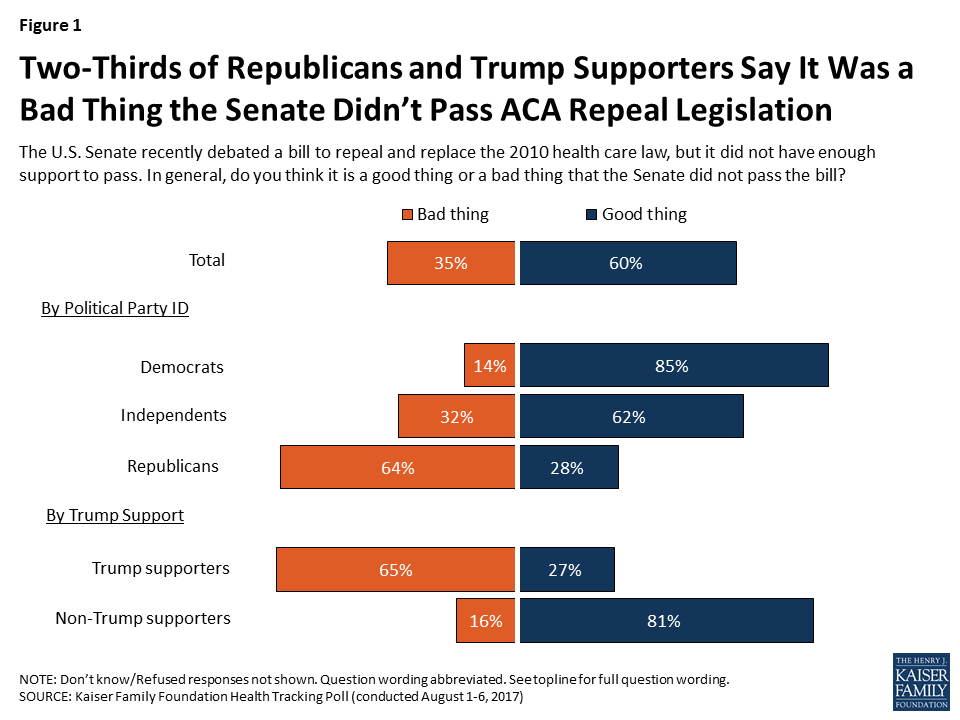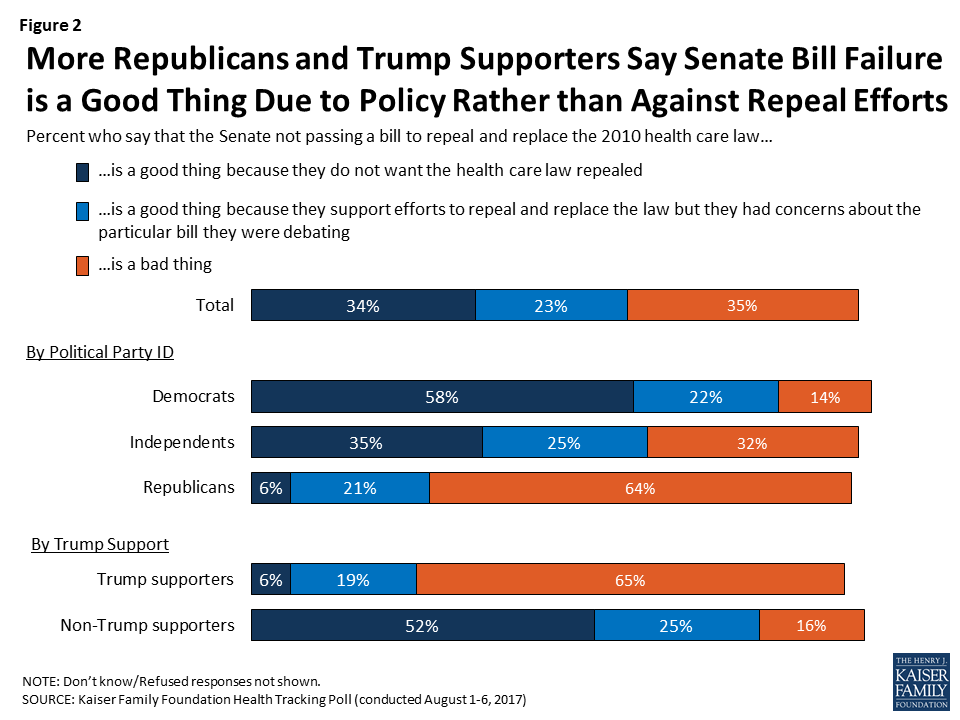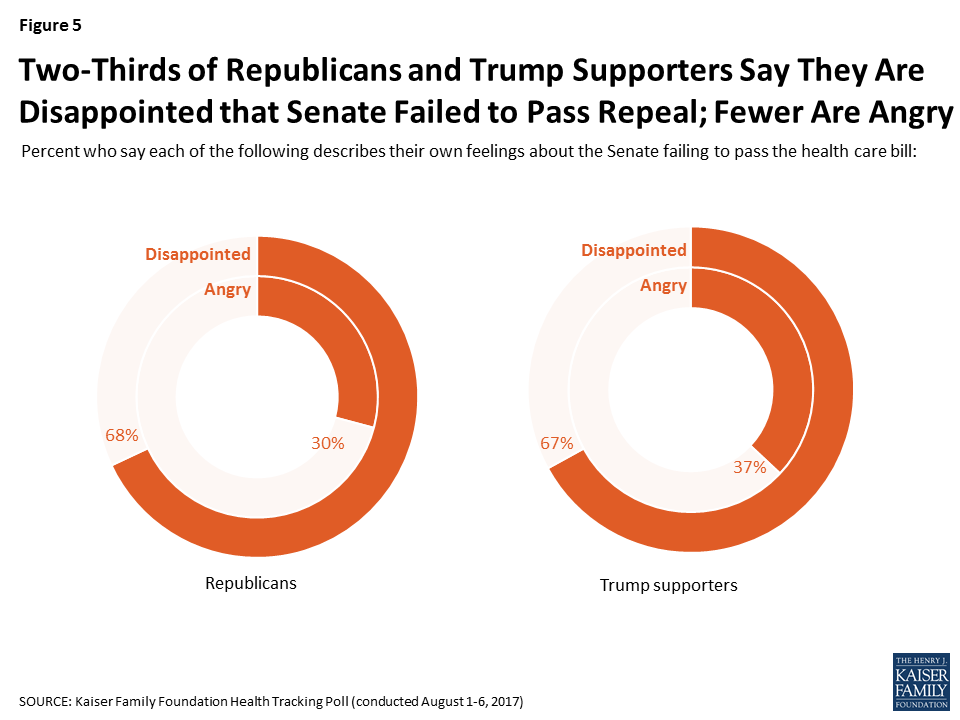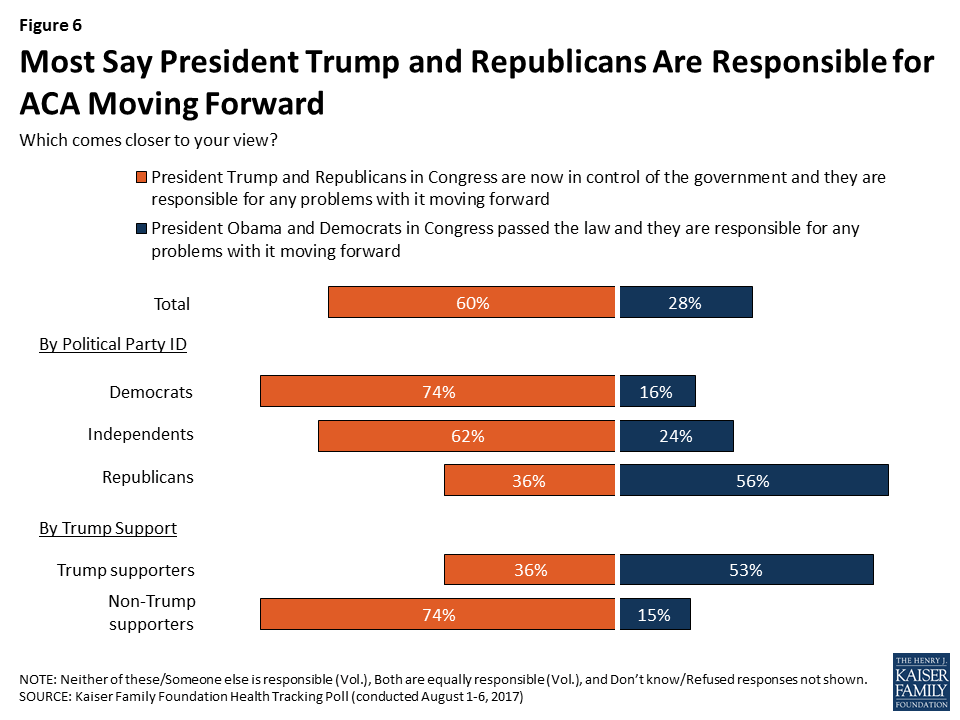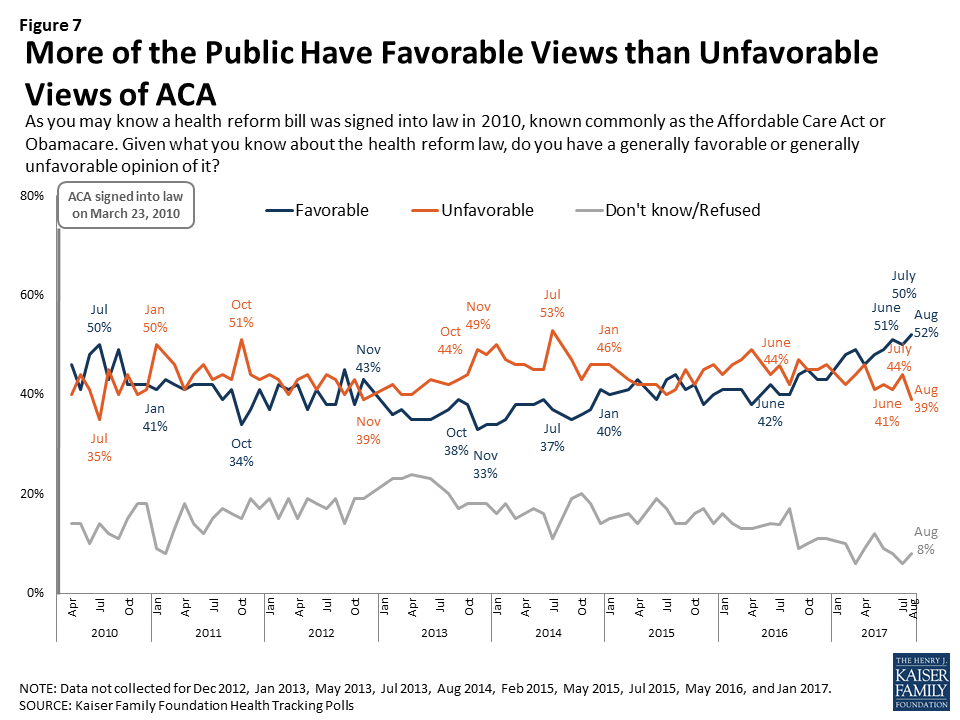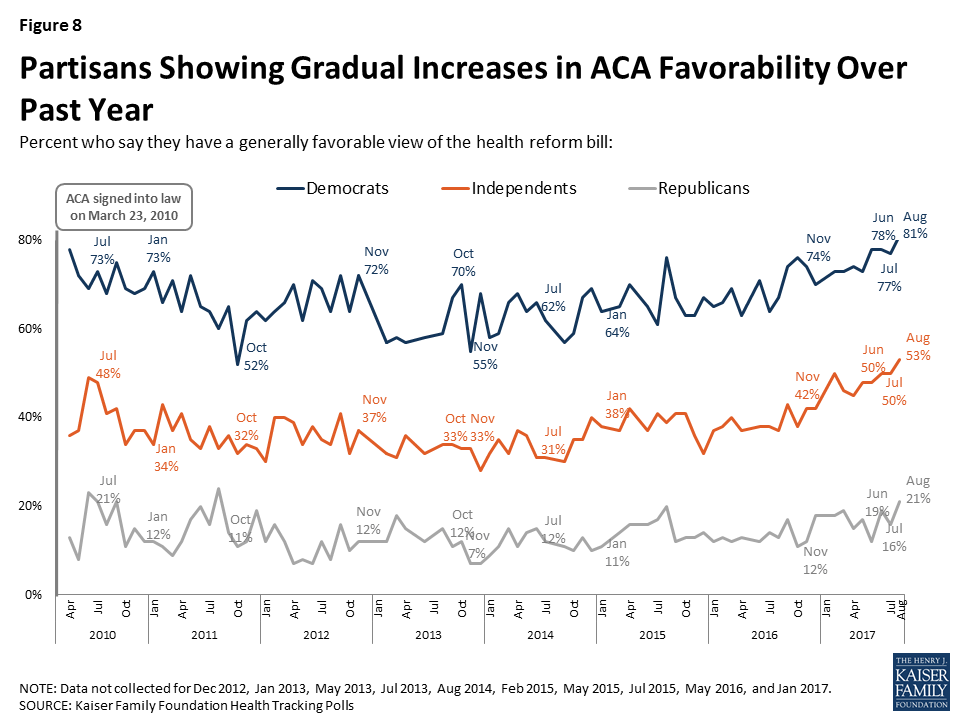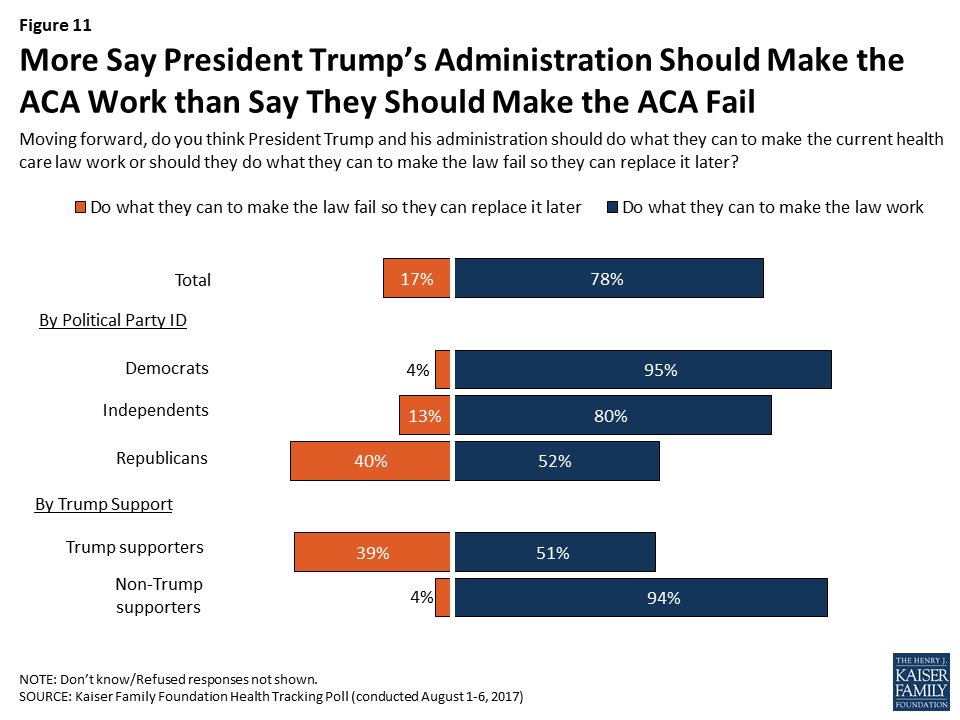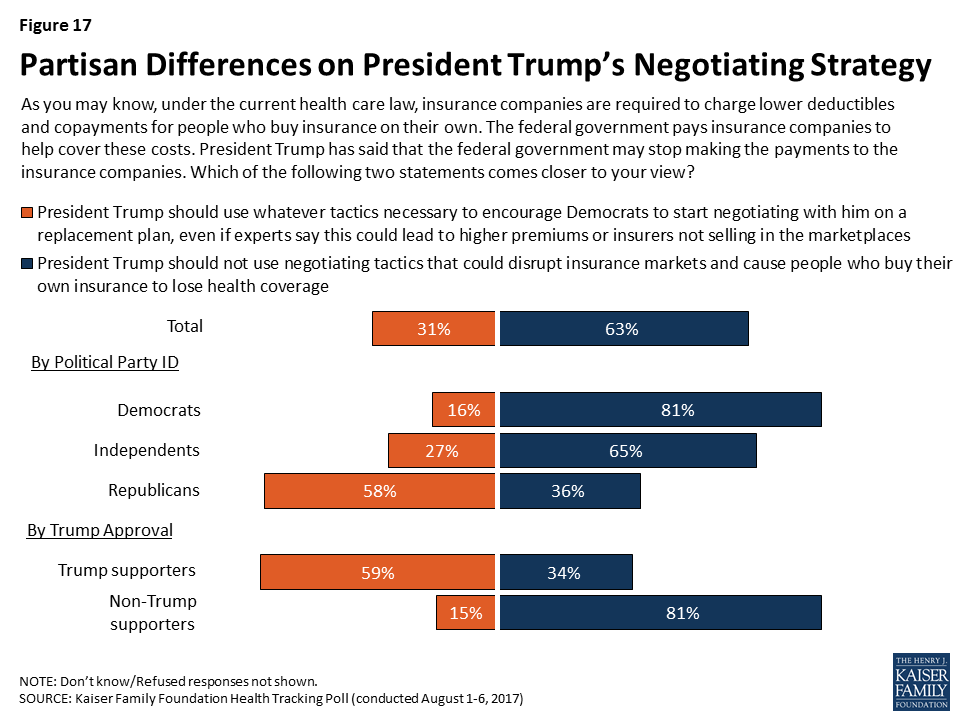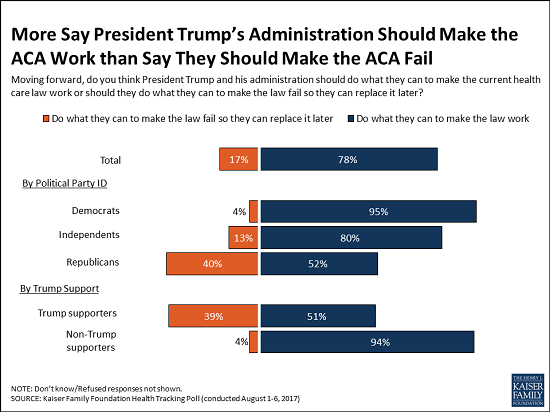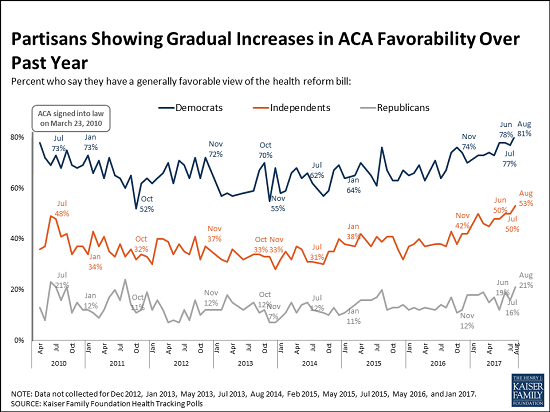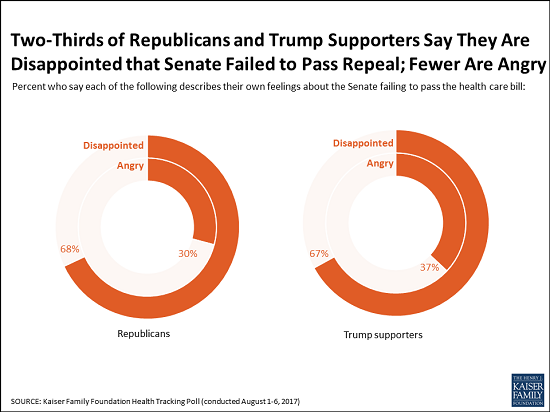Medicaid Enrollees and Work Requirements: Lessons From the TANF Experience
Issue Brief
Federal and state policymakers are considering proposals that would, for the first time, condition Medicaid eligibility on meeting a work requirement.1 Signaling a potential policy shift in this area, the Centers for Medicare and Medicaid Services (CMS) under the Trump Administration released a March 2017 letter to state governors stating that it will use Section 11152 authority to approve provisions involving “training, employment, and independence.”3 Medicaid work requirement proposals generally would require beneficiaries to verify their participation in approved activities, such as employment, job search, or job training programs, for a certain number of hours per week to receive health coverage. The proposals typically would exempt certain populations, but little detail is available to date about who would qualify for these exemptions, how the policies would be administered, and who would provide work support services. Having as many Medicaid enrollees in the workforce as possible is a worthy public goal, and in fact, many adults on Medicaid already are working. This issue brief considers the implications of conditioning Medicaid eligibility on satisfying a work requirement, drawing on state experience with TANF enrollees subject to a work requirement over the past two decades and data about work and the role of health coverage among Medicaid enrollees today.
Lessons from the TANF Experience with Work Requirements
Medicaid work requirement proposals often refer to the Temporary Assistance for Needy Families (TANF) program as a model. TANF provides federal block grant funding for states to assist low income parents and children. States must require adults receiving TANF cash assistance to participate in work. Although states have discretion in determining who must participate and the qualifying work activities, hours, and sanctions for noncompliance, states are subject to penalties if they fail to meet the TANF work performance measure. Federal law is very prescriptive about the hours and activities in which TANF enrollees must participate in order to count toward achieving the performance measure, and calculation of the TANF work performance measure considers most adult enrollees, even if a state chooses to exempt them. Box 1 below provides additional detail about the TANF work performance measure.
Box 1: The TANF Work Performance Measure
A state must meet the TANF work performance measure, referred to as the TANF Work Participation Rate, or face a fiscal penalty that reduces its federal TANF funds. The Work Participation Rate that a state must meet is calculated based on the share of enrollees who are participating in an approved activity for an average of 30 hours per week (20 hours for a single parent with a child under age 6), with limits on the extent that participation in job search, training, or education can count. States may exclude certain individuals from the work performance measure calculation, such as single parents who are caring for a child under age one, those caring for a family member with a disability, and those receiving Social Security Disability or SSI benefits.–For purposes of calculating a state’s TANF work performance measure, approved work activities4 include:
-unsubsidized employment;-subsidized private sector employment;-subsidized public sector employment;-work experience;-on-the-job training;-job search and job readiness assistance, including mental health and addiction treatment, generally limited to four consecutive weeks and six total weeks per year;-community service programs;-vocational educational training limited to 12 months;-job skills training directly related to employment;-education directly related to employment for those without a high school diploma or GED;-satisfactory high school or GED program attendance; and-providing child care for someone participating in community service.
Research finds that TANF enrollees work regardless of whether they are required to do so, suggesting that a work requirement has little impact on increasing employment over the long-term.5 Evaluations of mandatory work programs for cash assistance enrollees that examined employment generally have found that any initial increase in employment after imposition of a work requirement faded over time. After five years, those who were not required to work were just as likely or more likely to be working compared to those who were subject to a work requirement.6 These findings suggest that a work requirement is not predictive of employment.
TANF enrollees work in low wage jobs and remain poor despite being employed. TANF program evaluations have found that enrollees who were required to participate in a work program had incomes comparable to those who were not required to do so.7 Often, those who worked had replaced their cash assistance and food stamp dollars with dollars from earnings, but work had not lifted them out of poverty or increased their income relative to what they had received from TANF and food stamps.
Many individuals who are not working face significant employment barriers that work requirements do not address. Barriers to work often limit TANF enrollees’ employment prospects. These barriers include physical and mental health conditions, addiction, low educational attainment, limited work experience, criminal histories that impede hiring, domestic violence, and lack of affordable reliable childcare.8 Given their complex health and psychosocial needs, enrollees often require additional services and supports to help them address these barriers, such as physical or mental health treatment, education or training, criminal record expungement, and child care subsidies, so they are able to work.9 However, few employment programs inside and outside of TANF programs provide these additional services, at least in part because they are costly to provide and resources for work programs are limited.
Even the most successful programs that offer services to address employment barriers experienced by TANF enrollees leave the majority of participants unemployed. Overall, TANF enrollees who received services to identify and address medical and educational barriers to work in New York City’s Personal Roads to Individual Development and Employment program were more likely to become employed compared to those who did not receive services. However, nearly two-thirds of those who did receive services to address barriers never obtained employment.10 Philadelphia’s Transitional Work Corporation model initially produced higher employment rates and earnings among TANF enrollees who received job search assistance and work supports, such as case management and on-the-job mentors, compared to those who did not receive services; however, the increase faded over time. Enrollees in another Philadelphia model, the Success Through Employment Preparation program, received services to identify and address employment barriers, such as health problems or inadequate skills, but did not experience any increases in employment or earnings compared to those who did not receive services.11
The TANF work requirement has created some unintended consequences such as substantial administrative burden on state agencies. Administrative challenges result from the need to document, verify, and track enrollees’ participation in an approved work activity or combination of activities for the required number of hours each month.12 States may exempt certain enrollees from the work requirement, and administering these policies also requires time and resources.
The TANF work requirement may adversely affect enrollees who likely are eligible for an exemption based on a disability but did not obtain one.13 A report prepared for the U.S. Department of Health and Human Services noted that studies consistently show that TANF enrollees who are penalized for failing to meet a work requirement are more likely to have a disability compared to those who are not penalized.14 One study found that 41% of adults who left TANF but were unemployed had poor physical or mental health.15 Another report observed that individuals with severe but temporary disabilities may not be not exempt from a work requirement and may lose benefits, despite facing substantial barriers to employment as a result of their health needs.16 Research also has concluded that children of TANF enrollees who lose benefits for failure to comply with a work requirement are adversely affected. One study found that children in these families had higher rates of behavioral health problems.17
Implications of a Work Requirement for Medicaid
Proponents of Medicaid work requirements describe the policies as targeting “able-bodied” adults. However, many adults receiving Medicaid often face barriers to employment, similar to those experienced by TANF enrollees, such as physical or mental health disabilities, addiction, limited education or training, speaking a first language other than English, lack of access to affordable reliable child care and/or transportation, and domestic violence. Individuals facing these challenges require specialized supports to find and maintain employment, which Medicaid is not currently equipped to provide. The purpose of the Medicaid program, providing health coverage, also differs from TANF; one of TANF’s express purposes is to “end the dependence of needy parents on government benefits by promoting job preparation, work, and marriage.”18
Because many Medicaid enrollees already are working, a work requirement is anticipated to have a small impact on increasing employment.19 Among Medicaid enrollees, nearly 6 in 10 nonelderly adults are working, without being required to do so as a condition of coverage.20 In its amendment to its Section 1115 waiver extension application, Indiana proposes adding a work requirement. 21 However, Indiana estimates that 70% of enrollees would not be subject to the work requirement because about 1/3 of these enrollees already are working, and the remainder would qualify for an exemption because they are medically frail, in school, caring for a child, over age 60, pregnant, temporarily disabled, in substance use disorder treatment, or recently incarcerated.22 In its Section 1115 waiver application, Maine estimates that about 7% of its Medicaid enrollees would be subject to its work requirement before taking into account those who would qualify for exemptions such as being physically or mentally unable to work.23 Unlike Indiana, Maine has not expanded Medicaid under the ACA, so its coverage of adults is much more limited.
A work requirement will not reduce the need for health coverage through Medicaid because many of the jobs held by Medicaid enrollees do not offer health insurance. This is one reason why many Medicaid beneficiaries already are working. Most Medicaid adults work in industries with low offer rates for employer-sponsored insurance, such as agriculture and food service.24 As a result, working does not replace the need for Medicaid coverage in the way that wages can replace cash assistance dollars in TANF, and many low income workers depend on Medicaid for health insurance coverage. In TANF, enrollees’ income from work decreases TANF costs, which is not the case in Medicaid. In addition, access to jobs and employment benefits such as health insurance varies geographically. For example, nonelderly individuals in rural areas have a lower rate of private health insurance coverage compared to those in urban and other areas.25 This reflects rural individuals’ greater employment in jobs that do not offer employer-sponsored health insurance26 and the lower labor force participation rate in rural areas.
Health coverage through Medicaid is an important precursor to and support for work. Many of the jobs held by people with low incomes involve walking, standing, lifting and carrying objects, repetitive motions, and other physical labor. Without health insurance, individuals may forgo needed services, and their health may deteriorate to a point that interferes with their ability to work. An analysis of Ohio’s Medicaid expansion found that over half of enrollees who are working (without being required to do so) reported that having Medicaid made it easier for them to continue working.27 In addition, most Ohio expansion enrollees who were unemployed but looking for work reported that having Medicaid made it easier for them to seek employment.28 A study examining Michigan’s Medicaid expansion found that nearly seven in 10 (69%) enrollees who were working said they performed better at work once they got Medicaid coverage.29 Over half (55%) of Michigan expansion enrollees who were not working indicated that having Medicaid coverage made them better able to look for work.30 Having access to regular preventive health care to manage chronic conditions and address health issues as early as possible before they worsen is important so that individuals are healthy enough to work. In addition, an unmet need for mental health or addiction treatment results in greater difficulty with obtaining and maintaining employment,31 and Medicaid is an important source of coverage for mental health and addiction treatment services, such as opioid addiction.32
Most Medicaid adults who are not working report a major impediment in their ability to work or another responsibility that keeps them from working. After excluding those receiving SSI benefits, 35% of nonelderly Medicaid adults who are not working cite an illness or disability that prevents them from work.33 Others are not currently working because they are taking care of home or family (28%), in school (18%), looking for work (8%), or retired (8%).34 Medicaid work requirement proposals would not address these needs.
Similar to Medicaid’s role in supporting housing, state Medicaid programs can play a role in supporting work by providing referrals to job search or training programs without directly funding or requiring work supports. Unlike TANF, Medicaid does not have an existing infrastructure of work support programs on which to build. While some state Medicaid programs choose to offer supported employment services to people with disabilities (such as job coaching for people with intellectual or developmental disabilities who need help to learn how to do a particular task or work independently), these programs are small. State Medicaid programs are set up as health coverage programs, in most cases overseeing private health plans that manage and deliver medical and long-term care services – not as work programs that require the ability to conduct assessments to determine who is able to work, monitor work program participation, and develop relationships with employment and training providers and employers. In addition, the supported employment programs that Medicaid agencies provide are focused on offering services to assist those who are unable to work without the additional support that supported employment programs provide, rather than penalizing enrollees for failing to work by disenrolling them from coverage. In contrast to Medicaid’s infrastructure, TANF and its predecessor AFDC both include core initiatives focused on job training, education, and employment for enrollees receiving cash assistance. Medicaid’s role in supporting work is similar to its role in supporting housing.35 Medicaid funds cannot be used to directly fund housing, but Medicaid can provide services that support people with disabilities and those who are homeless with obtaining and maintaining housing and living independently. Similarly, Medicaid can provide referrals to voluntary work search and training programs and cover the services needed to keep people healthy and enable them to work.
While TANF spending on work activities and supports is critiqued by some as too low, it exceeds estimates of state Medicaid program spending to implement a work requirement. In 2015, states spent an average of $3,223 per work slot per year to provide work activities and supports (such as transportation and uniforms, but not including child care) for TANF enrollees who were required to work.36 For comparison, as part of its Medicaid work requirement proposal, Indiana has requested Section 1115 waiver expenditure authority to use federal Medicaid funds for orientation, assessment, job skills training, job search assistance, and tracking enrollee progress at an estimated cost of $90 per enrollee per month (or $1,080 per year).37 Other state waiver requests proposing Medicaid work requirements have not included spending estimates. For example, Arkansas indicates that it would work with its state department of workforce services to provide employment services for Medicaid enrollees subject to a work requirement.38 However, state workforce development programs do not have adequate funding and capacity to serve all of the individuals who would be subject to a Medicaid work requirement, and the President’s budget proposes cutting funds for the programs that currently provide job search and training assistance to unemployed and underemployed individuals. States need waiver authority to spend federal Medicaid funds on work requirements because these programs are beyond the scope of the medical and long-term care services that Medicaid can cover under federal law.
Medicaid work requirements can create additional administrative complexity and costs for states. States will have to devote their already limited staff and resources to tracking work program participation or incur the additional cost of contracting out that function. A draft operational protocol prepared for implementation of Kentucky’s proposed waiver that includes a work requirement illustrates the complexity involved. The state needs to create systems to share information about work participation and exemptions between the new “community engagement module,” the state’s Medicaid eligibility and claims processing systems, health plans, providers, and enrollees.39 Some exemption categories are temporary and must be re-evaluated and documented on a monthly basis.40 Kentucky recently amended its Medicaid work requirement proposal, citing administrative complexity as the reason for moving from a graduated work requirement (beginning at 5 hours/week and increasing to a maximum 20 hours/week) to a flat 20 hours/week.41 In its response to state-level public comments on its waiver amendment proposing a work requirement, Arkansas indicated that it “has conducted extensive planning on systems changes and other administrative issues” over the past six months in preparation.42 Arkansas acknowledged that administering a work requirement requires the state to build a new electronic portal for enrollee reporting, establish a process to identify a “catastrophic event” and refine its definition of “incapacitated” to exempt enrollees from the work requirement, and develop educational materials.43 The process to verify and document work requirement compliance and exemptions also could lead eligible Medicaid beneficiaries to lose coverage and experience interruptions or delays in accessing needed health care.44
Looking Ahead
Having as many Medicaid enrollees in the workforce as possible is a worthy public goal, and in fact, many adults on Medicaid already are working. The TANF experience demonstrates that many individuals who are not working face significant employment barriers and a work requirement might result in eligible people losing coverage. Medicaid can play a key role in ensuring that people who are able to work have the necessary supports, such as health coverage, to do so. In addition to fundamentally changing the Medicaid program, conditioning eligibility for health coverage on satisfying a work requirement, and terminating coverage for those who are unable to comply, is unlikely to result in substantial gains in employment, may contribute to administrative burdens, and could penalize the people who most need the health coverage that Medicaid provides.
Endnotes
- While the future of federal legislation affecting Medicaid is unclear at this time, the American Health Care Act passed by the House of Representatives and the Better Care Reconciliation Act considered by the Senate both included a state option to require certain Medicaid adults to participate in approved work activities. Kaiser Family Foundation, Compare Proposals to Replace the Affordable Care Act, http://modern.kff.org/interactive/proposals-to-replace-the-affordable-care-act/. Separately, some states are seeking Section 1115 waiver authority for Medicaid work requirements for adults newly eligible for coverage under the Affordable Care Act’s Medicaid expansion as well as for traditional Medicaid populations, such as low-income parents, those eligible for family planning services, and young adults aging out of foster care. Under the Obama Administration, CMS rejected state waiver requests for work requirements applied to Medicaid expansion adults as inconsistent with the program’s objectives to provide health coverage and care. Kaiser Family Foundation, Section 1115 Medicaid Expansion Waivers: A Look at Key Themes and State Specific Waiver Provisions (Aug. 2017), http://modern.kff.org/medicaid/issue-brief/section-1115-medicaid-expansion-waivers-a-look-at-key-themes-and-state-specific-waiver-provisions/; Kaiser Family Foundation, Proposed Medicaid Section 1115 Waivers in Maine and Wisconsin (July, 2017), http://modern.kff.org/medicaid/issue-brief/proposed-medicaid-section-1115-waivers-in-maine-and-wisconsin/; Kaiser Family Foundation, Medicaid and Work Requirements (March, 2017), http://modern.kff.org/medicaid/issue-brief/medicaid-and-work-requirements/; Kaiser Family Foundation, Three Key Questions: Section 1115 Medicaid Demonstration Waivers (Feb. 2017), http://modern.kff.org/medicaid/issue-brief/3-key-questions-section-1115-medicaid-demonstration-waivers/. ↩︎
- Section 1115 authorizes the Health and Human Services Secretary to authorize demonstration projects that test new approaches not otherwise permissible under federal law that, in Secretary’s judgment, advance program objectives. Some states have created voluntary job training and referral programs for Medicaid adults, but CMS under the Obama Administration noted that these are state-funded programs separate from approved Medicaid expansion waivers. ↩︎
- Letter from HHS Secretary Thomas E. Price and CMS Administrator Seema Verma to State Governors (March 2017), https://www.hhs.gov/sites/default/files/sec-price-admin-verma-ltr.pdf. ↩︎
- 42 U.S.C. § 607. ↩︎
- Some of this research looked at the AFDC program, the predecessor to TANF. ↩︎
- Gayle Hamilton et al., National Evaluation of Welfare-to-Work Strategies: How Effective are Difference Welfare-to-Work Approaches? Five-Year Adult and Child Impacts for Eleven Programs, (Washington, DC: Manpower Demonstration Research Corporation, December 2001), http://www.mdrc.org/sites/default/files/full_391.pdf. ↩︎
- Id. ↩︎
- Kelley Bowden and Daisy Goodman, “Barriers to Employment for Drug Dependent Postpartum Women,” Work 50, 3(2015): 425-32; Dan Bloom, Pamela J. Loprest, and Sheila R. Zedlewski, TANF Recipients with Barriers to Employment (Washington, DC: Urban Institute, May 2012), http://www.urban.org/research/publication/tanf-recipients-barriers-employment; Benjamin G. Druss and Elizabeth Reisinger Walker, Mental disorders and medical comorbidity, (Princeton, NJ: The Robert Wood Johnson Foundation, February 2011), http://www.integration.samhsa.gov/workforce/mental_disorders_and_medical_comorbidity.pdf; Judith A. Cook, “Employment Barriers for Persons with Psychiatric Disabilities: Updated of a Report for the President’s Commission,” Psychiatric Services 57, 10(2006):1391-405; Ellen Meara, “Welfare Reform, Employment, and Drug and Alcohol Use Among Low-Income Women,” Harvard Review of Psychiatry 14, 4(2006): 223-32. ↩︎
- John Martinez et al., Results from the Substance Abuse Case Management Program in New York City (New York, NY: MDRC, May, 2009), https://www.mdrc.org/sites/default/files/full_551.pdf; The National Center on Addiction and Substance Abuse at Columbia University, CASASARDSM: Intensive Case Management for Substance-Dependent Women Receiving Temporary Assistance for Needy Families (New York, NY: The National Center on Addiction and Substance Abuse at Columbia University, January 2009), https://www.centeronaddiction.org/addiction-research/reports/casasard-intensive-case-management-substance-dependent-women-receiving; Dan Bloom et al., Alternative Welfare-to-Work Strategies for the Hard-to-Employ (New York, NY: MDRC, October 2009), http://www.mdrc.org/sites/default/files/full_19.pdf; Dan Bloom, Cynthia Miller, and Gilda Azurdia, Results from the Personal Roads to Individual Development and Employment (PRIDE) Program in New York City (New York, NY: MDRC, July 2007), http://www.mdrc.org/sites/default/files/full_547.pdf. ↩︎
- Dan Bloom, Cynthia Miller, and Gilda Azurdia, Results from the Personal Roads to Individual Development and Employment (PRIDE) Program in New York City (New York, NY: MDRC, July 2007), http://www.mdrc.org/sites/default/files/full_547.pdf. ↩︎
- Dan Bloom et al., Alternative Welfare-to-Work Strategies for the Hard-to-Employ (New York, NY: MDRC, October 2009), http://www.mdrc.org/sites/default/files/full_19.pdf. ↩︎
- Government Accountability Office, Temporary Assistance for Needy Families: Potential Options to Improve Performance and Oversight (Washington, DC: Government Accountability Office, May 2013), http://www.gao.gov/assets/660/654614.pdf. ↩︎
- Some people may have physical or mental health conditions that limit functioning in ways that create barriers to work, yet do not rise to the level of severity required to qualify for SSI benefits. ↩︎
- Mathematica Policy Research, Assisting TANF Recipients Living with Disabilities to Obtain and Maintain Employment: Conducting In-Depth Assessments (Feb. 2008), https://www.acf.hhs.gov/sites/default/files/opre/conducting_in_depth.pdf. ↩︎
- Pamela Loprest, Disconnected Welfare Leavers Face Serious Risks (Washington, DC: Urban Institute, 2002), http://www.urban.org/sites/default/files/publication/59036/310839-Disconnected-Welfare-Leavers-Face-Serious-Risks.PDF. ↩︎
- Sharon Parrott, The New TANF Requirements and Individuals with Disabilities (Washington, DC: Center on Budget and Policy Priorities, March 2007), http://www.cbpp.org/research/the-new-tanf-requirements-and-individuals-with-disabilities. ↩︎
- Brenda J. Lohman et al., “Welfare Reform: What About the Children,” Welfare, Children & Families 02-1(2002): 1-8. ↩︎
- 42 U.S.C. § 601. ↩︎
- Drew Altman, Don’t Expect Medicaid Work Requirements to Make a Big Difference Axios (April 2017), https://modern.kff.org/medicaid/perspective/dont-expect-medicaid-work-requirements-to-make-a-big-difference/. ↩︎
- Excludes those receiving SSI benefits. Kaiser Family Foundation, Understanding the Intersection of Medicaid and Work (Feb. 2017), http://modern.kff.org/medicaid/issue-brief/understanding-the-intersection-of-medicaid-and-work/. ↩︎
- Ind. Family & Soc. Servs. Admin. Amendment Request to Healthy Indiana Plan Section 1115 Waiver Extension Application (July 20, 2017), https://www.medicaid.gov/Medicaid-CHIP-Program-Information/By-Topics/Waivers/1115/downloads/in/in-healthy-indiana-plan-support-20-pa5.pdf. ↩︎
- Id. ↩︎
- Maine Dep’t of Health & Human Servs. 1115 Waiver Application (Aug. 2, 2017), http://www.maine.gov/dhhs/oms/rules/MaineCare_1115_application_080217_to%20submit.pdf. ↩︎
- Kaiser Family Foundation, Understanding the Intersection of Medicaid and Work (Feb. 2017), http://modern.kff.org/medicaid/issue-brief/understanding-the-intersection-of-medicaid-and-work/. ↩︎
- Kaiser Family Foundation, The Role of Medicaid in Rural America (April 2017), http://modern.kff.org/medicaid/issue-brief/the-role-of-medicaid-in-rural-america/. ↩︎
- Kaiser Family Foundation analysis of 2015 American Community Survey 1-Year Estimates. ↩︎
- Kaiser Family Foundation, The Effects of Medicaid Expansion under the ACA: Updated Findings from a Literature Review (Feb. 2017), http://modern.kff.org/medicaid/issue-brief/the-effects-of-medicaid-expansion-under-the-aca-updated-findings-from-a-literature-review/. ↩︎
- Id. ↩︎
- Univ. of Mich. Institute for Healthcare Pol’y & Innovation, Medicaid Expansion Helped Enrollees Do Better at Work or in Job Searches (June 2017), http://ihpi.umich.edu/news/medicaid-expansion-helped-enrollees-do-better-work-or-job-searches. ↩︎
- Id. ↩︎
- National Institute on Drug Abuse, Consequences of Drug Misuse (Bethesda, MD: National Institute on Drug Abuse, March 2017), https://www.drugabuse.gov/related-topics/health-consequences-drug-misuse; Neil Jordan et al., “Economic Benefit of Chemical Dependency Treatment to Employers,” Journal of Substance Abuse Treatment 34, 3(2008):311-319; Ronald C. Kessler et al., “Depression in the Workplace: Effects on Short-term Disability,” Health Affairs (Millwood) 18, 5(1999):163-71; Cheryl J. Cherpitel and Yu Ye, “Drug Use and Problem Drinking Associated with Primary Care and Emergency Room Utilization in the US General Population: Data from the 2005 National Alcohol Survey,” Drug and Alcohol Dependence 97 3(2008):226-30; Doris J. James and Lauren E. Glaze, Mental Health Problems of Prison and Jail Inmates (Washington, DC: US Department of Justice, December 2006), https://www.bjs.gov/content/pub/pdf/mhppji.pdf. ↩︎
- Kaiser Family Foundation, Medicaid’s Role in Addressing the Opioid Epidemic (June 2017); Kaiser Family Foundation, Medicaid’s Role in Behavioral Health (May 2017). ↩︎
- Kaiser Family Foundation, Understanding the Intersection of Medicaid and Work (Feb. 2017), http://modern.kff.org/medicaid/issue-brief/understanding-the-intersection-of-medicaid-and-work/. ↩︎
- Id. ↩︎
- See, e.g., Kaiser Family Foundation, Linking Medicaid and Supportive Housing: Opportunities and On-the-Ground Examples (Jan. 2017), http://modern.kff.org/report-section/linking-medicaid-and-supportive-housing-issue-brief/. ↩︎
- Calculated based on $2.9 billion total annual TANF spending on work activities and supports in 2015, https://www.cbpp.org/research/family-income-support/how-states-use-funds-under-the-tanf-block-grant, for 930,000 people required to participate in TANF work activities each month in 2015, https://www.acf.hhs.gov/ofa/resource/work-participation-rates-fiscal-year-2015 (Table 4B). A work slot may be occupied by more than one person over the course of a year. ↩︎
- Kaiser Family Foundation, Section 1115 Medicaid Expansion Waivers: A Look at Key Themes and State Specific Waiver Provisions (Aug. 2017), http://modern.kff.org/medicaid/issue-brief/section-1115-medicaid-expansion-waivers-a-look-at-key-themes-and-state-specific-waiver-provisions/. ↩︎
- Proposed Amendment to Ark. Works Section 1115 Medicaid waiver (June 2017), https://www.medicaid.gov/Medicaid-CHIP-Program-Information/By-Topics/Waivers/1115/downloads/ar/ar-works-pa2.pdf. ↩︎
- Kentucky HEALTH Program Requirements Specification (April 4, 2017 draft), http://media.mcguirewoods.com/mwc/kentucky-medicaid-expansion-2.pdf (see especially pp. 34-44). ↩︎
- Id. at 35. ↩︎
- Kaiser Family Foundation, Proposed Changes to Medicaid Expansion in Kentucky (Aug. 2017), http://modern.kff.org/medicaid/fact-sheet/proposed-changes-to-medicaid-expansion-in-kentucky/. ↩︎
- Ark. Proposed Amendment to Ark. Works Section 1115 Medicaid waiver (June 2017), https://www.medicaid.gov/Medicaid-CHIP-Program-Information/By-Topics/Waivers/1115/downloads/ar/ar-works-pa2.pdf. ↩︎
- Id. ↩︎
- Sara Rosenbaum et al. What Might a Medicaid Work Requirement Mean? (May 31, 2017), http://www.commonwealthfund.org/publications/blog/2017/may/medicaid-work-requirement. ↩︎
